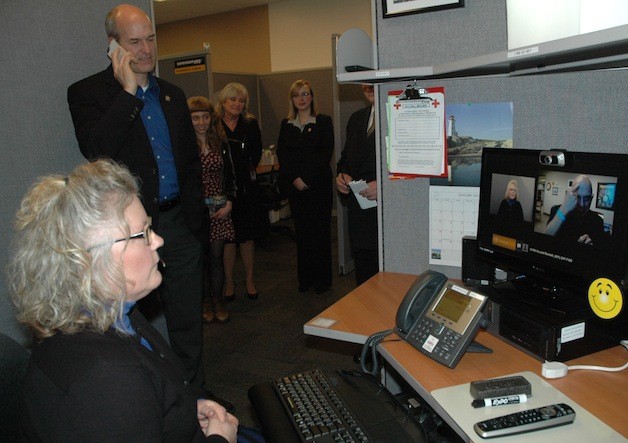SMOKEY POINT — Even though Ron Burdett is deaf, he still enjoys calling friends and family on the phone to talk about the Seattle Seahawks.
And a few days before this year’s Super Bowl, he had a chance to chat with U.S. Rep. Rick Larsen about the team’s chances, thanks to Lisa Flatt, a video relay interpreter at the Sorenson Interpretation Center in Smokey Point.
Larsen visited the center Jan. 30 to see how interpreters use video phone technology to see deaf people’s sign language and facial expressions, and then translate those into words for hearing people on the other end of the line.
“The problem with texting or other words on a screen is that you can’t express emotions that way,” said Michael Maddix, director of government and regulator affairs for Sorenson, which has grown from 22 to 60 interpreters over seven and a half years.
Mary Burns, interpreting director of the Smokey Point center, said the local branch began with only 10 cubicles, but now has about 20 interpreters from 6 a.m. to 11 p.m.
Although Sorenson has 98 video interpreting centers in America, and 10 more in Canada, FCC regulations require the Smokey Point center to be able to take calls from anywhere in the nation, to avoid preferential treatment.
“That actually helps us, because we have a higher concentration of deaf people in the Pacific Northwest, so they’d be waiting longer to get access to an interpreter otherwise,” Maddix said. “American Sign Language is like American English, in that there are regional accents to it, so when we get calls from certain areas, that can be a challenge.”
Sorenson takes 911 calls from deaf callers, which they prioritize above all else, to the point of making sure a second interpreter is there to translate the caller’s words to dispatchers correctly. However, many of their calls are focused on the socialization that hearing people tend to take for granted.
“Cyber Monday is one of our busiest days of the year,” Maddix said. “It’s a logistical nightmare. When we started, we expected that Mother’s Day would be huge, but it wasn’t what we anticipated. Father’s Day, on the other hand, was huge. We soon figured out that our callers go to visit their mothers, but call their fathers.”
The one exception is Hispanic families, which is one reason why Sorenson has Spanish-language interpreters in Smokey Point. Likewise, the Northwest has a greater number of people diagnosed with Usher’s Syndrome, which causes them to go progressively deaf and blind. Sorenson’s interpreters are equipped with blue and black backgrounds, and even different-colored smocks, to make them stand out visually.
Flatt has seen phone technology for the deaf evolve since her grandparents’ day.
“They had this big metal keyboard, and they could only use it to talk to other deaf people,” Flatt said. “The machine was so huge they had to keep it in the basement.”
From there, the technology progressed to Teletypewriters, and then to Video Relay Services, the latter of which has been indispensable for deaf people like Burdett.
“I’m the vice president of my company,” Burdett told Larsen, though Flatt, over the phone. “I wind up doing a lot of communicating. If I had to use TTY for all of that communication, the other people at my company wouldn’t like me very much. I might not even be vice president.
“The interpreters are wonderful to work with,” Burdett signed while smiling. “As deaf people, we need to have this tool in our toolbox.”
Before filming a quick clip of himself signing the words “Go Seahawks,” Larsen commended them for their work.
“I had no idea this type of service even existed,” Larsen said.


